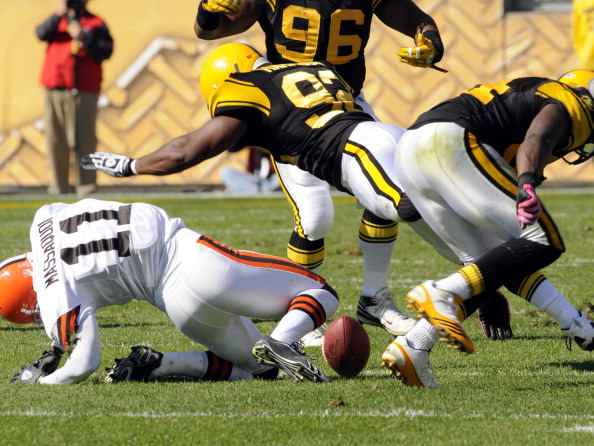Ben McGrath writes a shocking article in the January 31 New Yorker. Drawing partly on the extensive reporting of Alan Schwartz in the New York Times, he traces the high rate of degenerative neurological diseases like chronic traumatic encephalopathy (C.T.E.) and amyotrophic lateral sclerosis (A.L.S.) in football players. “N.F.L. players,” McGrath writes, “are five to nineteen times as likely as the general population to have received a dementia-related diagnosis.” On one Sunday last October, “at least eleven N.F.L. players were concussed.” Since the impact of head-to-head run-ins on the field is equivalent to minor car crashes, a knowledgeable observer estimates that 20 percent of pro players on the field are already suffering incipient dementia. Nor are these injuries confined to professional games.
Between 1982 and 2009 according to the National Center for Catastrophic Injury Research, 295 fatalities directly or indirectly resulted from high-school football. From 1977 to 2009, at all levels, 307 cervical-cord injuries were recorded. And between 1984 and 2009 there were 133 instances of brain damage—not slowly accruing damage, as in the case of C.T.E., but damage upon impact.
Has the game always caused such injuries? If we look back at photos from the past—say, the era of the football hero Red Grange in the 1920s—it is surprising to see how little protected the players were, with leather skull-cap helmets and minimal padding of the shoulders. But the players now are bigger, faster, steroid-enhanced, and trained to superhuman feats. The Packers’ defensive line for this year’s Super Bowl weighs on average 320 pounds. Besides, the equipment supposedly protecting these giants amounts to lethal weaponry—big crash-impact helmets and semi-metallic shoulder pads, which can be steered into opponents with tank-like impetus. Protections become projectile armaments.
This “protection” is like the boxing gloves mandated by the Marquess of Queensberry Rules in 1867. Some supposed they were meant to protect a fighter’s hands. Their real function was to make it possible to strike at an opponent’s head with maximum force. Back in the days of bare-knuckle fights, the only way to do real damage to another man’s head, without crippling oneself, was to break his nose with the heel of the hand. Otherwise, the long bouts were waged with wallops to the muscle-padded torso. The gloves made it possible to score knockouts to the head—and to do that head permanent damage, registered in the high degree of dementia among fighters.
The same “gain” has been achieved for football with the heavy helmet. When the amount of concussions—and the possibility of law suits—began to disturb owners and referees, some new guidelines were used against head-to-head collisions. More penalties began to be called. The violent headhunter James Harrison of the Pittsburgh Steelers was fined $75,000 for a vicious helmet-to-helmet hit on Mohamed Massaquoi of the Cleveland Browns. But fans, protesting, sent the millionaire player donations to pay his fine, and a picture of his mayhem was sold in gift shops as a souvenir. Players and others claimed that violence is the essence of football. When a knee injury made the Chicago Bears quarterback Jay Cutler withdraw from this year’s NFL championship, he was called “wussy” and denounced on Twitter by his fellow NFL players. Playing through pain is the point of the game, and broken bodies are the price of fame. Your whole future life does not matter compared with the game.
The same thing was said about boxing when it was proposed that headguards, of the kind used in amateur bouts and in training camps, should be worn by professional fighters. Then, even those who claimed that boxing was a matter of timing and artistry, admitted that violence is the essence of boxing: What would be the fun if knockouts were not possible? I was brought up by a father who was a boxing coach and Golden Gloves judge. He took me ringside to watch the matches. But after I met the brain-damaged Muhammad Ali, I vowed never to watch another boxing event, and never have. Perhaps, if violence is the essence of football, I should give that up too.
I am reminded of Saint Augustine’s friend, Alypius, who was fond of gladiator games in the arena. After Augustine persuaded him to give up this addiction, some friends dragged Alypius off to the fights, and he resolved to close his eyes and pay no attention. But the noise of the crowd made him open his eyes. Augustine describes the result in Confessions:
The minute he saw blood, he was sipping animality, and turned no more away. With eyes glued to the spectacle, he absentmindedly gulped down frenzies. He took a complicit joy in the fighting, and was drunk with delight at the cruelty. No longer the person he was when he entered, he was now entered into the crowd, at one with those who forced him there. More—he stared, he shouted, he burned, he took away the madness he had found there and followed it back again, not only with those who had first drawn him, but dragging them and others on his own.
There is the reality behind the Super Bowl—superb young bodies being broken, and irretrievable harm being done to brains.
Advertisement



